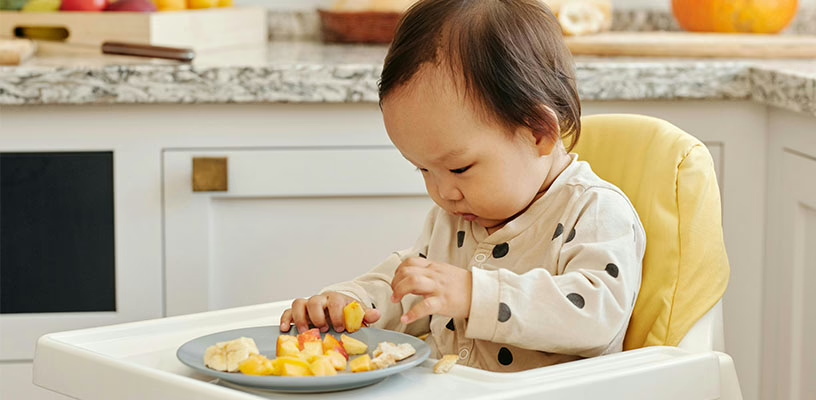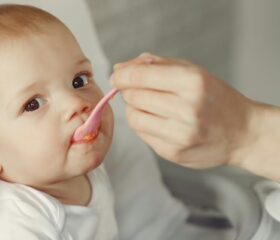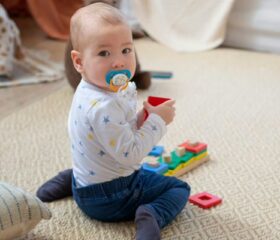Baby-Led Weaning: How to Introduce Solid Foods to Your Baby
Throughout your baby’s first year, she'll reach plenty of important milestones. One of the biggest (and messiest) of these is when she starts eating solid foods.

Introducing your little one to solids can be intimidating, and may conjure up images of your baby (and your kitchen) splattered with pureed foods like an abstract art piece. To avoid this, an increasing number of parents are trying a method that forgoes the traditional baby goo—baby-led weaning.
What, exactly, is baby-led weaning? Is there really an advantage to skipping purees, and what are the risks of jumping straight to solid foods? Read on to find out.
What is baby-led weaning?
Baby-led weaning (BLW) is a method that consists of offering soft, manageable finger foods to your baby (instead of feeding her purees or practicing spoon-feeding). The idea is that she’ll be able to grasp and eat these independently, allowing her to feed themselves right from the start of the weaning process.
The concept of BLW was popularized by Gill Rapley and Tracey Murkett in their 2009 book “Baby-Led Weaning: Helping Your Baby to Love Good Food.” They emphasize letting your baby participate in family meals and learn by observing others.
This lets your baby:
- Decide on her own how much to eat
- Recognize when she’s full
- Familiarize herself with a wide variety of textures much earlier
All of this teaches her to manage her hunger and may make her a less picky eater later in life.
Note that BLW is meant to complement breast milk or formula, not replace it. The primary purpose of introducing solid foods is to help your baby practice eating, but breast milk (or formula) should remain your baby’s primary source of nutrition during her first year. 1
Can you mix baby-led weaning with traditional spoon-feeding?
Yes, you can combine BLW with spoon-feeding, and many parents do. For example, you can offer finger foods alongside spoon-fed options like yogurt (it’s a good idea to give your baby yogurt as one of her first solid foods) or oatmeal. The key is to allow your baby to self-feed as much as possible, even if you preload a spoon for her to use.
When should you start baby-led weaning?
The ideal time to begin baby-led weaning is around 6 months of age. 2
At this stage, most babies are developmentally ready to explore solid foods (while, again, still receiving the majority of their nutrition from breast milk or formula). Don’t introduce solids if your baby is under 4 months old. 2
It’s important to remember that every baby is unique, and if yours isn’t ready to start until a little later, that’s not necessarily a problem. To determine if your baby is ready for BLW, look for the following signs:
- Sitting upright with minimal support: Your baby should have good head and neck control to safely manage solid foods.
- Loss of tongue-thrust reflex: This reflex, which causes babies to push food out of their mouths, should be diminished or gone.
- Ability to grasp and bring objects to the mouth: Babies need a certain amount of strength and coordination to pick up finger foods and self-feed.
- Interest in table foods: Your baby should show an interest in food, such as watching others eat, reaching for food, or showing curiosity about meals.
If your baby was born prematurely or has any developmental delays, she might take longer to show these signs. If so, speak with your pediatrician before trying to introduce your baby to solids.
Do babies need teeth for BLW?
No, babies can handle BLW without teeth. Their gums are strong enough to mash soft foods, provided you prepare the food appropriately.
Pros and cons of baby-led weaning
Baby-led weaning has both pros and cons, listed below.
Reasons to consider baby-led feeding
While it won’t necessarily help with the mess—enterprising babies can manage to throw solids as well as purees—BLW offers several advantages for both you and your child:
- Self-regulation of appetite: Again, letting your baby decide how much to eat will help her learn to recognize when she’s hungry and full. This may reduce the risk of overeating and obesity later in life because she’ll have practiced stopping eating when she’s satisfied.
- Exposure to a variety of foods: Nobody wants to cook for a picky eater, right? BLW introduces your baby to a range of textures, flavors, and food types early on, which can help shape healthier and more adventurous eating habits.
- Development of motor skills: Self-feeding gives your baby plenty of opportunities to practice her fine motor skills, such as the pincer grasp, which come in handy when grasping food and bringing it to her mouth, as well as the oral skills required for chewing and swallowing.
- Social integration: BLW includes your baby in family mealtimes. Watching you and others eat will socialize them and help her learn through imitation.
- Convenience and cost-efficiency: With BLW, you can prepare the same meals for the whole family (albeit adjusting textures and portion sizes to suit your baby). This eliminates the need for separate baby food, which will save both time and money.
What are the challenges of baby-led feeding?
BLW certainly offers a lot of benefits, but it’s not without its challenges, too. These include:
- Messiness: Sadly, there’s no way around the mess of introducing solids to your little one. Self-feeding can get particularly messy, especially in the early stages when your baby is first learning to handle food.
- Potential for nutritional deficiencies: Letting your baby dictate how much she eats could mean she won’t get enough nutrients, particularly if she’s a fussy one. When you practice BLW, make sure you’re closely observing your baby—she can’t completely take the lead.
- Choking hazards: Choking is a common concern regardless of whether you’re practicing BLW or not, but there’s an additional risk if you’re trying BLW and giving your baby bigger handfuls. (On that note, it’s important to differentiate between choking and gagging. Gagging is a natural reflex that helps babies learn to manage solid foods safely, and is not the same as choking, although you should watch for both.)
Fortunately, most of these challenges can be overcome with enough effort. Toward the end of this article, we’ll go over a few tips that will help you transition to baby-led weaning more smoothly.
Should you expose your baby to potential allergens?
Many pediatricians recommend introducing common allergens early and often to reduce the risk of your infant developing food allergies later in life. 3
You can offer your baby eggs, peanuts, fish, and dairy in safe forms (e.g., scrambled eggs, thinly spread nut butter, flaked fish, etc.). Introduce one allergenic food at a time, wait a few days before trying another, and always monitor your baby for signs of an allergic reaction, such as:
- Hives
- Vomiting
- Rash
- Swelling of the lips or face
It probably goes without saying, but if your baby has severe symptoms (anaphylaxis), such as difficulty breathing, wheezing, severe swelling, or a drop in her alertness, seek emergency medical care immediately.
Keep track of what food you offered and when in your journal or baby tracker app to help your doctor narrow down the list of suspects if your baby has a reaction. The best baby trackers also let you document everything with pictures and notes for easy reference.
If you’re worried about exposing your baby to potential allergens, it’s never a bad idea to consult with your pediatrician first.
How to safely practice BLW with your baby
If you’re ready to try BLW with your baby, here’s how to get started:
Make sure your baby is ready
Don’t rush introducing your baby to solids. Make sure your baby is showing the telltale signs that she’s ready.
Set up a safe eating environment with a sturdy high chair that will keep your baby upright and well-supported. Always supervise your baby during meals—the ”baby-led” nature of this method should only go so far.
Start slowly
Start with just one solid meal a day, preferably during a family mealtime, so your baby can observe and mimic your eating habits. Gradually increase the number of solid meals over time, following your baby’s cues.
Choose the right foods
Choose soft, easily manageable foods to help your baby explore new textures at a reasonable pace (remember, eating too quickly can make your baby gassy). Begin with finger-sized strips that are easy to grasp. As her motor skills improve, transition your baby to slightly larger, bite-sized pieces.
The best foods to start with are:
- Iron-rich foods: Iron is a particularly important nutrient for your baby at this stage, and if she doesn’t get enough, it could affect her development or even cause anemia. 4 You can give your baby soft-cooked meat, poultry, beans, lentils, and iron-fortified cereals.
- Foods high in protein: Serve scrambled or boiled eggs, deboned and flaked fish, tofu strips, soft cheese, and plain, full-fat yogurt. Mashed beans and lentils are also good sources of protein as well as iron.
- Foods with healthy fats: Include foods like mashed or sliced avocado, thinly spread nut butters, and full-fat dairy products, such as yogurt and cheese.
- Fruits and vegetables: Ripe fruits like bananas and mashed pears are naturally soft and don’t need any special preparation. Vegetables like carrots and broccoli need to be steamed until they’re tender.
- Whole grains: Serve complex carbs, like oatmeal (rather than simple ones, like bread made from refined flour).
What foods should you avoid?
Avoid choking hazards like whole grapes, hard raw vegetables, nuts, and thick globs of nut butter. Additionally, note that babies can’t have honey until they’re 1 year old, as it is one of the main vectors of C. botulinum, the bacterial spore that can cause infant botulism. 5
Consider taking infant CPR sessions
Taking an infant CPR class will equip you with the skills to handle emergencies confidently. Hopefully, you’ll never have to use them, but they could potentially save your baby’s life.
Let your baby lead
The clue is in the name! Let your baby take the lead during BLW meals. Let her decide what and how much to eat, avoid pressuring her, and don’t try to take over and spoon-feed her.
Your role is to offer a variety of safe, nutritious foods and create a supportive environment for her to learn and enjoy eating.
What if your baby isn’t eating much at first?
If you find your baby isn’t eating much to start with, don’t panic. It’s normal for babies to consume small amounts when you first give them solids.
As you’re probably gathering, BLW is as much about exploration and practice as it is about eating. Your baby will continue to get most of her nutrition from breastmilk or formula for a while, so just focus on creating a positive mealtime experience and let her set the pace.
How do you know when your baby is full?
Your baby is probably better at regulating her appetite than you might expect. You’ll know she’s full when she:
- Turns her head away
- Loses interest in the food
- Plays with food instead of eating it
- Pushes her food away
It’s understandable if you’re concerned about your baby eating enough, but respect these cues, and try not to worry.
Final thoughts
As with so many aspects of parenting, there’s no one-size-fits-all approach to introducing solids to your baby. Every child is different, even when they’re very young, and there’s no single “right” way to feed your child.
While BLW offers plenty of benefits, it doesn’t have to be an all-or-nothing approach. Try to combine it with traditional spoon-feeding or adapt the method in other ways based on how it seems like it’s going.
Most importantly, make sure you stock up on paper towels. No matter how you choose to give your baby solid food, it’s going to be messy!
Article Sources
- Johns Hopkins Medicine. "Feeding Guide for the First Year" Retrieved July 16, 2025.
- Centers for Disease Control and Prevention. "When, What, and How to Introduce Solid Foods" Retrieved July 16, 2025.
- National Health Service. "Food allergies in babies and young children" Retrieved July 16, 2025.
- MedlinePlus. "Anemia caused by low iron - infants and toddlers" Retrieved July 16, 2025.
- Infant Botulism Treatment and Prevention Program. "When to Avoid Honey" Retrieved July 16, 2025.







